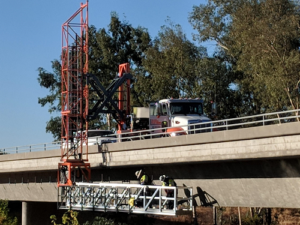Technology never rests.
Tools, equipment, devices, and processes continually change and evolve along with the technology behind them. Advances never even dreamed of half a century ago are now commonplace. Technology exists today that didn’t even have a purpose just a lifetime ago.
But some things never change. And the need for conducting hands-on, visual and tactile inspections of bridge structures is one of these.

An Eye in the Sky: Bridge Inspections and UAVs
Driven by the never-changing need for closeup visual inspection, the rise of Unmanned Aerial Vehicles, or UAVs, has led to companies that specialize in providing drones for bridge, tower, and even wind turbine inspections.
There are certainly advantages to having a relatively inexpensive and small device hover within a few feet of high-voltage power lines, for example.
As one article notes,
“Power line inspections are an expensive, time-consuming affair. The California Public Utilities Commission requires a visual inspection of each power line every 1–2 years and a detailed inspection every 3–5 years, a frequency typical of most states. Such inspections usually require one of three methods: walk, drive, or fly. For rural power lines in remote areas, rough terrain makes walking or driving nearly impossible — not to mention excruciatingly slow. As a result, most utility companies opt for helicopter-based power line inspections.”
However, with UAVs, or drones, the expense of helicopters can be eliminated. And this same advantage can be had with wind turbine inspections, as well.
According to a whitepaper published on the topic,
“Drones provide a practical solution for the inspection of wind turbines, as well as associated infrastructure such as feeder poles, collector lines, and electrical substations. Drones support business efforts to avoid hazardous man-hours; reduce costs for maintenance, inspections, and repairs; and minimize downtime.”
One might think that, with the advances in UAV technology combined with the ongoing efforts to miniaturize and optimize onboard optics, that these craft would be displacing aerial access vehicles and equipment for bridge inspections and maintenance tasks.
Not so much.
Despite the valid claims of many UAV inspection services, a drone can only provide part of the functions needed to conduct a proper bridge inspection.
Bridge Inspections Must Be Hands-On to Be Complete
While a drone can certainly provide a cost-effective method for providing a surface visual inspection and record of a bridge structure, there’s not much else it can do. When the Hernando de Soto bridge was discovered to have a severe crack in a key structural element, drones were dispatched to capture video and still images of the damage.
This was a quick, inexpensive, and convenient method for accessing the bridge structure beneath the bridge deck. But this was soon followed up by an in-depth, hands-on inspection.
As engineering firm SEH states,
“While 21st century bridge inspection procedures include everything from snooper trucks to aerial drones to ground-penetrating radar and ultrasonic testing equipment, simple visual, tactile and auditory techniques remain the most reliable and cost-effective methods for detecting deficiencies.”
These are techniques that are unattainable with UAVs.
According to one SEH inspector, more than 99 percent of inspection techniques are visual, auditory or tactile. For example, “sounding” and other tactics are used to determine how safe a bridge is.
Typically, many problems can often be found by tapping the surface of a bridge or using a rotary impact tool across the bridge surface and listening to the difference in the way the tapping sounds. When the sounds change from a high-pitched clacking to a low rumbling noise, there is evidence the bridge deck may be delaminating underneath.
Delamination is a condition of the top layer of concrete separating from the layer below it. This separation can allow moisture to deteriorate the interior of the structure, destroying it from the inside out.
On many bridges, rust on steel components is an issue. UAVs may be able to detect rust on the surface of a structure, but they can do nothing more. Inspectors, on the other hand, can assess the severity of rust as well as determine the cleanliness of steel surfaces prior to any repainting.
Additionally, despite the versatility of UAVs in accessing under bridge structural areas, they face issues and even limitations brought on by wind and signal interruptions caused by the bridge structures themselves. Bridge inspectors, on the other hand, don’t require GPS to operate.
Under Bridge Platforms: Providing the Best from the Plains to the West
The team at Under Bridge Platforms serves all of the Western States, including California, Washington, Oregon, Idaho, Nevada, Montana, and Wyoming, providing the best in high quality under bridge access equipment.
Our large and expanding inventory of under bridge access platforms includes state-of-the-art self-drive access platforms such as the versatile Truck Mounted Hydra Platform HPT43 and the Aspen Aerials A-30 Bridge Inspection Unit.
There are a variety of different bridge inspection platform vehicles featuring multiple capabilities. In addition, determining the best choice for your work or project also depends on both the structure and the terrain.
So, while cost is certainly important, the vehicle capabilities and your specific project needs should be the dominant deciding factors in your equipment rental decision.
As a professional firm you can rely on to guide you through the process, buying or renting the right under bridge inspection vehicle and bridge inspection platform equipment for your project means we are here to help you make the proper selection.
We take a great deal of pride in being the only company in our industry based in California that offers total under bridge access. By offering high quality customer service, we have managed to build long-lasting relationships with our esteemed customers. And we intend to keep it that way.
Contact us today and let us help take care of all your under bridge platform needs.

Recent Comments